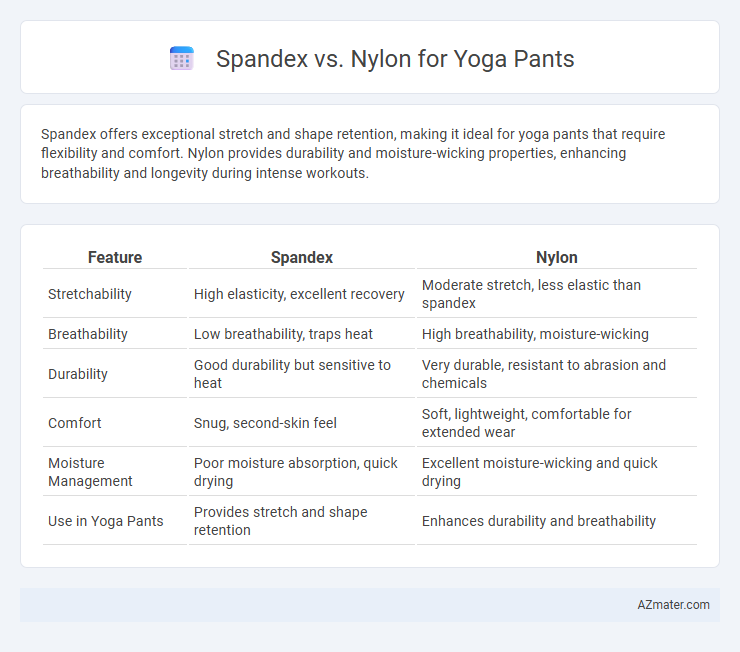Spandex offers exceptional stretch and shape retention, making it ideal for yoga pants that require flexibility and comfort. Nylon provides durability and moisture-wicking properties, enhancing breathability and longevity during intense workouts.
Table of Comparison
| Feature | Spandex | Nylon |
|---|---|---|
| Stretchability | High elasticity, excellent recovery | Moderate stretch, less elastic than spandex |
| Breathability | Low breathability, traps heat | High breathability, moisture-wicking |
| Durability | Good durability but sensitive to heat | Very durable, resistant to abrasion and chemicals |
| Comfort | Snug, second-skin feel | Soft, lightweight, comfortable for extended wear |
| Moisture Management | Poor moisture absorption, quick drying | Excellent moisture-wicking and quick drying |
| Use in Yoga Pants | Provides stretch and shape retention | Enhances durability and breathability |
Introduction: Why Fabric Choice Matters for Yoga Pants
Fabric choice critically impacts yoga pants performance, comfort, and durability during exercise. Spandex offers exceptional stretch and shape retention, enhancing flexibility and body contouring. Nylon provides moisture-wicking properties, strength, and abrasion resistance, making it ideal for intense yoga sessions and long-term wear.
Spandex vs Nylon: Quick Fabric Overview
Spandex offers exceptional stretch and shape retention, making it ideal for yoga pants that require flexibility and a snug fit during movement. Nylon provides durability, moisture-wicking properties, and a smooth texture that enhances comfort and breathability in activewear. Combining spandex with nylon creates a balanced fabric blend that supports both elasticity and strength for optimal performance in yoga apparel.
Comfort and Stretch: Which Delivers Better Flexibility?
Spandex offers superior stretch and flexibility for yoga pants, providing up to 500% elongation, which enhances freedom of movement during poses. Nylon, while durable and moisture-wicking, has less elasticity and often requires blending with spandex to achieve comparable flexibility. Choosing yoga pants with a higher spandex content ensures optimal comfort and unrestricted mobility for active practice.
Durability: Comparing Longevity and Wear Resistance
Spandex offers excellent stretch and recovery, making yoga pants resilient to repeated movements and maintaining shape over time. Nylon fibers deliver superior abrasion resistance and moisture-wicking properties, enhancing overall durability and comfort during intense workouts. Combining spandex with nylon creates a balanced fabric blend that maximizes longevity and wear resistance for yoga apparel.
Moisture-Wicking and Breathability: Performance in Action
Spandex offers superior stretch and shape retention but lacks advanced moisture-wicking capabilities compared to nylon, which excels at drawing sweat away from the skin to keep you dry during intense yoga sessions. Nylon's breathable fibers enhance airflow, reducing overheating and increasing comfort, making it ideal for high-sweat activities. Combining spandex with nylon blends these strengths, delivering flexible, breathable yoga pants that maintain dryness and comfort throughout workout performance.
Fit and Shape Retention: Which Maintains Form?
Spandex offers superior elasticity and excellent shape retention, making it ideal for yoga pants that need to maintain a snug, flexible fit during intense movements. Nylon provides durability and a smooth texture but lacks the same degree of stretch and recovery, often leading to less consistent shape maintenance over time. For yoga pants prioritizing fit and long-lasting form, spandex blends outperform nylon in maintaining original shape and comfort.
Skin Sensitivity: Hypoallergenic Considerations
Spandex is generally hypoallergenic and less likely to cause irritation, making it suitable for sensitive skin during yoga sessions. Nylon, while durable and moisture-wicking, can sometimes trigger allergic reactions in individuals with skin sensitivities. Choosing spandex-blend yoga pants often ensures better comfort and reduces the risk of irritation for those prone to skin allergies.
Care and Maintenance: Washing and Drying Differences
Spandex requires gentle washing in cold water with mild detergent to maintain its elasticity, while nylon can tolerate slightly warmer water but still benefits from a gentle cycle to preserve fabric integrity. Avoiding high heat drying is crucial for both fabrics; spandex should be air-dried or laid flat to prevent damage, whereas nylon can be tumble-dried on low heat but air drying is preferred to extend garment lifespan. Proper care enhances yoga pant durability, ensuring spandex retains stretch and nylon maintains strength and shape over time.
Eco-Friendliness: Sustainability Profile
Spandex, typically made from petroleum-based polyurethane, presents challenges in biodegradability and recycling, making it less sustainable compared to nylon. Nylon production consumes significant energy and releases greenhouse gases but innovations in recycled nylon, such as Econyl derived from ocean waste, improve its eco-friendliness substantially. Choosing yoga pants made from recycled nylon supports circular fashion initiatives, reducing environmental impact compared to conventional spandex blends.
Final Verdict: Choosing the Right Fabric for Your Yoga Pants
Spandex offers superior stretch and recovery, making it ideal for yoga pants requiring maximum flexibility and comfort during movement. Nylon provides durability, moisture-wicking properties, and a smooth finish, ensuring long-lasting wear and breathability. Selecting the right fabric depends on whether you prioritize stretch and shape retention (spandex) or strength and moisture management (nylon) for your yoga practice.

Infographic: Spandex vs Nylon for Yoga Pant
 azmater.com
azmater.com